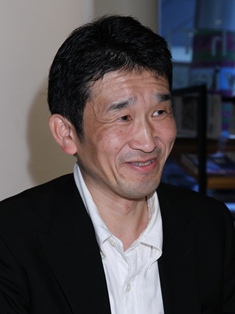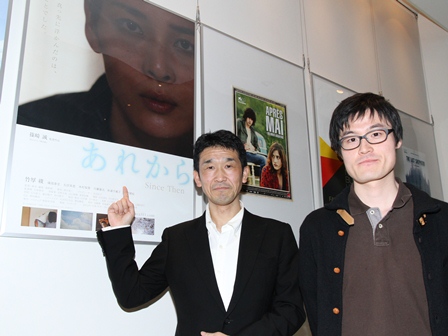Interview with Director Makoto Shinozaki (“Since Then”)

Makoto Shinozaki’s “Since Then” dramatizes how Tokyoites felt and reacted immediately after the earthquake and tsunami of 3.11. Shinozaki perfectly captures the eerie calm and uncertainty that gripped the “rest” of Japan during that time.
– You’ve had a long career of making films. You’ve made all sorts of films in different genres. Is there any sort of recurring theme, idea or inspirations that you see in your films – into this film?
Makoto Shinozaki: I don’t have a good answer because I haven’t been able analyze my own films. But if I were to pick one theme, I would think it would be the relationships between human beings.
– I understand that before you started making films you were a film critic – and you analyzed other people’s films.
Shinozaki: No I don’t think so.
– I found this film interesting because I seen other films, documentaries, that talk about 3.11, mainly describing what happened in Tohoku – talking with survivors and the big issues of the tragedy. But your film has a completely different focus. Where were you when 3.11 happened?
Shinozaki: I was home in Tokyo. I was about to leave home and then the earthquake started. And I wanted to call my wife but I couldn’t get in touch with her. And I was really worried about my children because as you know, the earthquake struck at 2:46, right when schooled ended – when the kids were on their way home. So, I offered some space to stay for the kids in the neighborhood because many parents were at work, a long way from home. So there were a lot kids at my place on that day. And I put up signs to notify the folks in the neighborhood that their kids were at my house. And I didn’t want to get the kids too worried so I didn’t turn on the TV and I kept talking to them until their parents arrived.
– I feel that you captured the feeling of what it was like in Tokyo when the disaster happened and afterwards. Did the characters of the story develop out of people you knew or some other ideas and feelings that you had? It’s not exactly your story of the disaster. It’s a woman’s story.
Shinozaki: There was actually a model for the character. The protagonist is a woman, of course. But this was more based on a buddy I had in college who was very emotionally traumatized for about 10 years. He had some psychological problems. He had left Tohoku. He was living elsewhere – a safe and sound life. And then the earthquake struck. Again, he became emotionally unstable. I couldn’t get in touch with him at that time for about one and half months. It’s not that the boyfriend character in the story is depicting that individual. It’s of course, a bit imaginative. But as a model, there was that one friend. And that friend had actually checked himself into a hospital. But after he checked out of the hospital he married his girlfriend.
– Great! Is your friend doing OK now?
Shinozaki: Of course. I went to him to ask if we could do their story… well, not exactly their story, but something based on it… and luckily he said yes. If he said no, we wouldn’t have made the film.
– Did the woman, in real life, have a similar problem to the character in the film in having a problem in getting in contact with him and was stuck in some limbo for a while?
Shinozaki: The situation with the girlfriend was that she had heard from the family that he had been taken to a hospital but apparently it wasn’t the hospital that he usually went to. So, none of the doctors there knew of his whereabouts.
– Let’s talk about the movie itself. For your protagonist, you chose her job to be the owner of a shoe store, particularly orthopedic shoes – special shoes. Could you comment on the reason why you chose that particular occupation?
Shinozaki: There were discussions with the students – I worked with students at the Tokyo Film School – about what this woman did for a living. First, there was the idea to have her work in a supermarket, to make her one of the procurement people. Because then, you could depict how after the earthquake there was no water, there was no food. But little by little, as daily life came back to normal, the rhythm [of life] came back. It would very well synchronize with arc the story. But we thought that would be a little too explanatory, so we did away with that idea. Instead, one of the students, Iwasaki, who was an assistant in the production, came up with the idea of the shoe store. And I had heard about how for women it was too difficult to walk in high heels, so they would buy sports shoes or sneakers. And another reason I thought it was a good idea was because it’s not all that often you see someone working in a shoe store in a movie. And also it’s the feet, among all the organs in the human body, are most sensitive to what’s happening on the ground. What’s your idea?
– I think that maybe in a larger symbolism, her job is to help people, with perfect shoes that make them walk through life easier. She herself doesn’t do that until the very end when she puts on her own sneakers that allow her to move forward and take control of her own life a little bit more.
Shinozaki: Your answer is perfect.

– I know! Somebody had posted a quick review of this film… obviously an English speaker… and they equated the idea of “soul” with “sole.” I thought that was going too far.
Shinozaki: That’s beautiful! We actually interviewed some people who do this as a profession. It was very interesting in that these people, as was depicted in the film, take measurements to make the perfect fitting shoe. Doing that also requires a lot of psychological analysis. So that by examining the soles of one’s feet you can tell if the weight is always on the right, or is it always on the left, what kind of profession does that person work in. So, these people take a lot of pride in what they do. It’s not just about selling products, which Japan is too often about, but it’s more about offering an outlet. I thought that to be very interesting.
– There are a couple of other very symbolic images in the film – the photograph of the sky and the bird mobile. Traditionally, on the surface, images of freedom, openness and flying, but they seem a bit different in the film. Can you tell me about them?
Shinozaki: Of course, there was a hole in the wall that you needed to cover up. There was a lot of discussion with the students as to what kind of poster to put there. There weren’t a lot of ideas forthcoming. I intuitively wanted a poster of the sky. It wasn’t premeditated symbolism or anything. It was just what I intuitively wanted.
– And then there was the bird mobile. That makes one think of the sky. There was one moment where you had a shot looking down at with the shadows of birds crossing her face and then it cuts back to looking at the birds in front of it. It made me think of Hitchcock’s “The Birds” for one second. I thought instead of an image of freedom and flight there was an image of total oppressiveness.
Shinozaki: Coming back to the first question you had – if there was a certain theme that threads through all of my pictures – when I see someone who is solitary, in a room which is not necessarily locked, in this case she could go out if she wanted to, but she doesn’t… she’s locked in, but she’s not – that kind of thing interests me. There’s another thing about the birds, as you mentioned Hitchcock. Birds happen to be the most sensitive of all animals. One of the students on the film, who was the production designer, saw this seagull mobile. She asked me whether we could use it. I checked the price and it was a little too expensive. So I decided to have the same kind of mobile made by a friend of hers. That was actually a hand-made mobile. And when you’re in that room, you have to depict the slightest tremors or wind, so that mobile came in very handy. It was a perfect way to depict those things.
– It seems there was a lot of collaboration with the students. Can you tell me how this worked?
Shinozaki: I had a basic storyline in mind, which I gave to fourteen students. But if I continued this way, it would have been a case of having too many cooks. So, I decided to go with my own idea and from then on, it became a project between me and my student assistant, Zenzo. There’s on particular idea of his I picked. You remember the scene at the wedding ceremony where she sees the video of her ex-boyfriend. That was Zenzo’s idea and I really like it. One detail that I added was that she and her boyfriend on screen would have eye-to-eye contact. So, the idea of having eye contact with someone who’s already in the past at that point – it’s a moment! There’s this kind of metastructure where you have someone connecting to the past, but outside of that, the audience watching the movie is connecting with the past.

Makoto Shinozaki (Director / left), Zenzo Sakai (Writer / right)
Interview by Nicholas Vroman



















